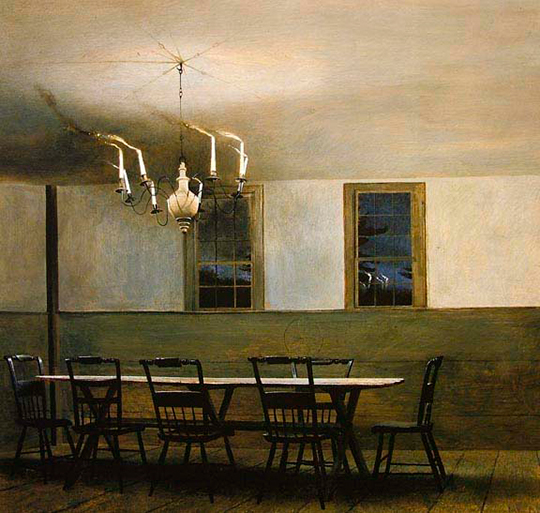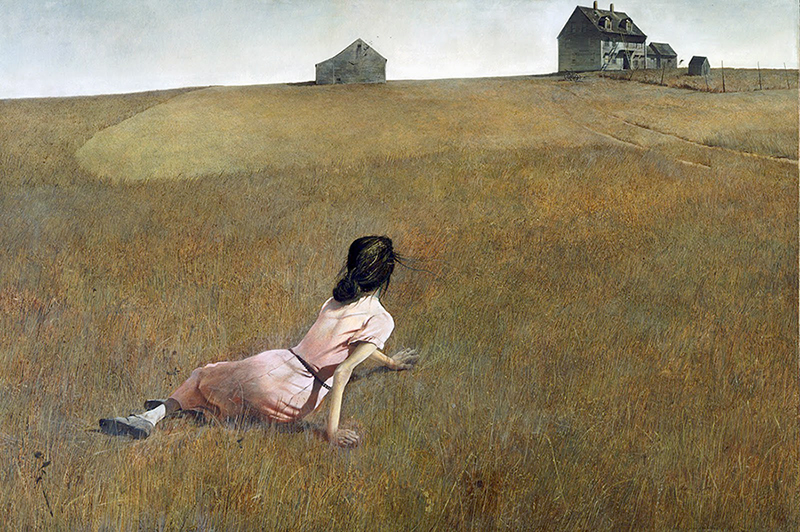Andrew Wyeth – One of the Best-known U.S. Artists of the Middle 20th Century
Wyeth was born July 12th 1917 and passed away January 16th 2009. He started drawing at a young age and was home-tutored because of his frail health as a child (interesting that he lived until 91 years old!). His father was an illustrator and artist (N.C. (Newell Convers) Wyeth), and his primary teacher who is said to have kept him sheltered and “obsessively focused”. Wyeth recalled of that time: “Pa kept me almost in a jail, just kept me to himself in my own world, and he wouldn’t let anyone in on it. I was almost made to stay in Robin Hood’s Sherwood Forest with Maid Marion and the rebels.”
By the time Wyeth was a teenager he had ongoing art lessons by his father, the only lessons he ever had. Under his father’s guidance he mastered figures study and learned techniques of many of the masters, especially Winslow Homer. His father guided him into illustration which was not his passion, however he produced these works under his father’s name while in his teens.
At the age of twenty, Wyeth had his first one-man exhibition of watercolors at the Macbeth Gallery in New York City. The entire inventory of paintings sold out, and his life path seemed certain.
His art path and talent was most certain, however tragedy struck Wyeth’s life when his father died in a tragic train accident when his car stalled on the tracks. Not only did this change his life but also the style of his work, the melancholic style that he is best known for today. The seed of creativity took root in not only Wyeth’s life but years later in his son, Jamie Wyeth, who followed his father’s and grandfather’s footsteps, becoming the third generation of Wyeth artists.
Christina’s World
In the 1940’s, Wyeth married Betsy Janes and through her met Christina Olson, who would become the model for the iconic Christina’s World. Wyeth was inspired by Christina, who, crippled with polio and unable to walk, spent most of her time at home. To him she was a model of dignity who refused to use a wheelchair and preferred to live in squalor rather than be beholden to anyone. It was dignity of a particularly dour, hardened, misanthropic sort, to which Wyeth throughout his career seemed to gravitate.
The painting however is actually composed with three different models. The figure’s wasted limbs and pink dress belong to Christina Olson. The youthful head and torso, however, belong to Betsy Wyeth who was then in her mid-20s (as opposed to Christina’s then-mid-50s). The most famous “model” in this scene is the Olson farmhouse itself, on the National Register of Historic Places since 1995.
Snatched up for $1,800
When Wyeth completed Christina World he thought the work was a “complete flat tire”. He sent if off to the Macbeth Gellery in Manhattan in 1948. It was hardly noticed after its completion, mainly because the Abstract Expressionists were making most of the arts news and the founding director of the Museum of Modern Art, Alfred Barr, purchased it immediately for $1,800. A smart move and intuition on a masterpiece that would become the icon for Wyeth.
Popularity – In the 1980’s collectors paid more that $1 million for his paintings.
After “Christina’s World” Wyeth’s fame skyrocketed. In 1949, Winston Churchill asked for Wyeth watercolors to decorate his room at the Ritz-Carlton in Boston. Harvard gave Wyeth an honorary degree in 1955. He made the cover of Time in 1963 when President Johnson gave him the Presidential Medal of Freedom. He painted portraits of Presidents Eisenhower and Nixon. A show of his work toured the country in 1966 and 1967, attracting huge crowds at the Pennsylvania Academy of Fine Arts in Philadelphia, the Whitney Museum and the Art Institute of Chicago. In the 1980’s during the 80’s, Japanese collectors were paying more than $1 million for a Wyeth.
In 1963, he was the first painter to receive the Presidential Medal of Freedom. In the following decade, he was the first American since John Singer Sargent elected to the Academie des Beaux-Arts, and he was asked to join the Soviet Academy of the Arts; he was subsequently the first living American artist elected to the British Royal Academy. In 1988, he was awarded the Congress Medal of Honor, the highest civilian honor awarded by Congress, with appreciation of an “austere vision” that “has displayed the depth and dignity of rural American life.”
In 2007, Wyeth received the National Medal of Arts, cited by the National Endowment for the Arts for portraying “an inner life that is elusive and enigmatic.” The artist’s reputation for secrecy had become intensified when his ample portfolio of neighbor Helga Tesorf was revealed in 1986. Working with this striking model for fifteen years, Wyeth made 246 sketches, studies, drawings, and paintings, and the magazine-cover stories were accompanied by speculation as to the nature of their relationship.
The implication of sex and Wyeth’s celebrity propelled Helga onto the covers of Time and Newsweek. The National Gallery of Art in Washington, which rarely organized shows of living artists, leapt to do an exhibition of the Helga pictures in 1987. The catalogue, with reproductions of Wyeth’s soft-core renditions of his recumbent model, became a Book-of-the-Month Club best seller.
The works and a few others were sold to a Japanese collector reportedly for $45 million.
Wyeth reached great and deserving fame as an artist. He stayed true to his style and passion though art was being redefined all around him by the Abstract Expressionists, who by the way didn’t like him.
For myself, Wyeth is my favorite American Artist. His style of work strikes a cord of nostalgia, an expression of solitude and sometimes sadness.













